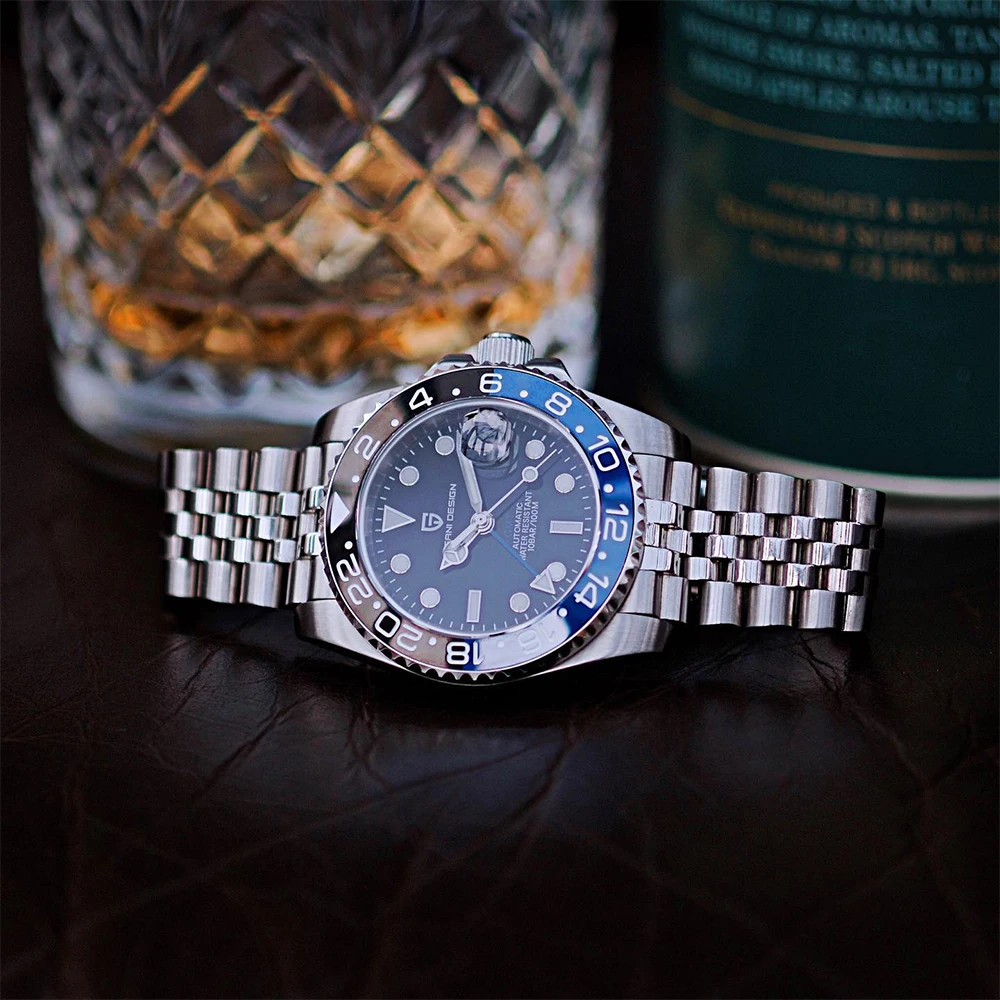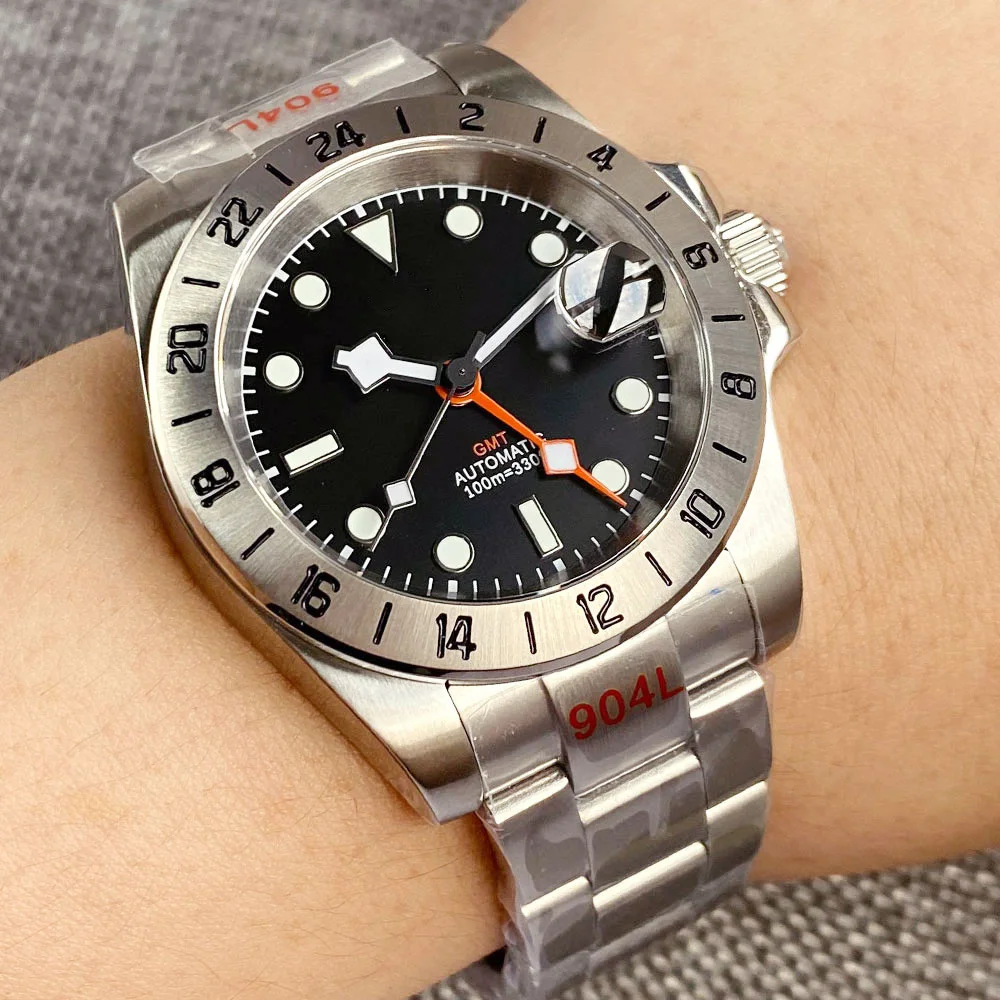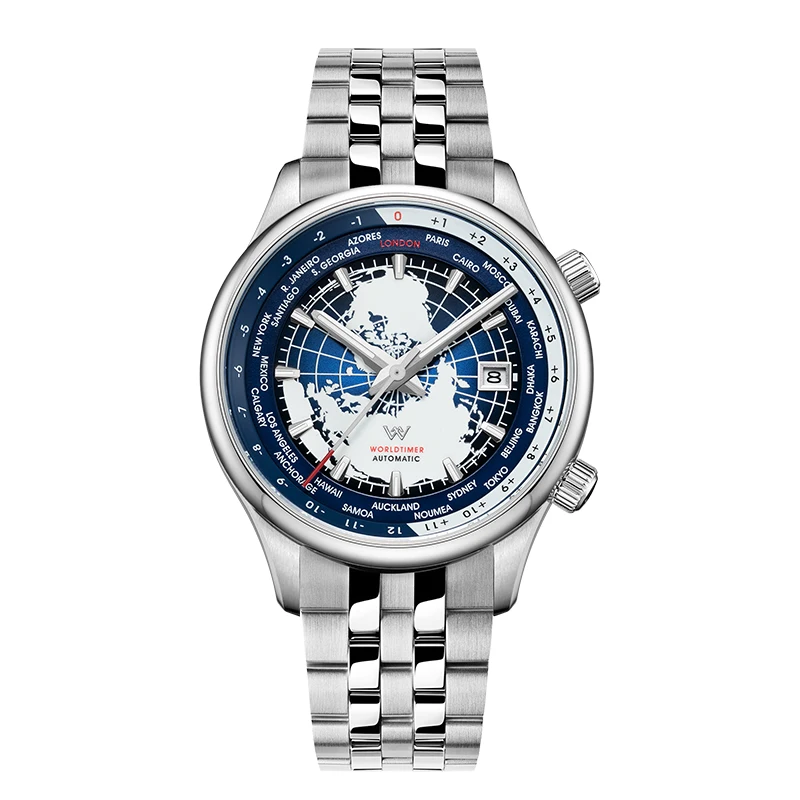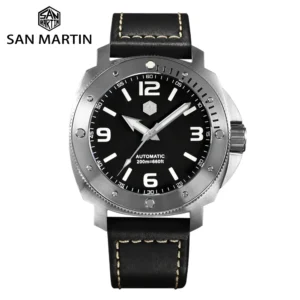What is a GMT Watch and Why Do You Need One?
A GMT watch is a specialized timepiece designed to track multiple time zones simultaneously, making it an invaluable tool for those who travel or communicate internationally.
GMT Watch Definition:
A GMT watch features an additional hand that completes one full rotation every 24 hours, allowing the wearer to track a second time zone while maintaining local time display.
The term “GMT” stands for Greenwich Mean Time, which originated in the mid-19th century when the Royal Observatory in Greenwich, England, was established as the global reference point for timekeeping. Today, most modern timepieces reference UTC (Coordinated Universal Time), which has essentially replaced GMT as the world’s time standard, though the “GMT” designation remains the common terminology for these watches.
The practical applications for GMT watches extend beyond just frequent flyers. Business professionals conducting international calls, those with family overseas, remote workers collaborating with global teams, and even investors tracking multiple financial markets all benefit from having instant access to different time zones.
The development of the GMT watch has a fascinating history, with the Rolex GMT-Master being one of the first, created in the 1950s specifically for Pan American Airways pilots who were flying the new transatlantic routes. This connection to history of specialized watch development shows how timepieces have evolved to solve specific professional challenges.
For those interested in exploring options, our collection of GMT automatic watches offers various styles with this practical functionality.
The Anatomy of a GMT Watch: Key Components
Understanding how GMT watches work starts with recognizing their unique components and how they differ from standard timepieces.
Standard Components:
- Hour, Minute, and Second Hands: These function just like on a conventional watch, displaying the current local time in a 12-hour format.
GMT-Specific Components:
GMT Hand: The heart of the GMT functionality is this additional hand, which makes one complete rotation every 24 hours (rather than twice daily like the standard hour hand). The GMT hand is typically designed to stand out visually, often featuring an arrow tip or bright color (commonly red, orange, or yellow) to distinguish it from other hands.
24-Hour Scale: To read the GMT hand properly, a 24-hour scale is essential. This can appear in various locations:
- On the dial face (inner ring)
- On an inner flange (the angled section between the dial and crystal)
On the bezel (outer ring surrounding the crystal)
Rotating Bezel: Many GMT watches feature a bi-directional rotating bezel marked with 24-hour graduations. This component is crucial for tracking a third time zone, as we’ll explore later.
The mechanics behind these features involve specialized gearing within the movement. The GMT hand rotates at exactly half the speed of the regular hour hand, allowing it to complete one rotation per day instead of two. This is achieved through intricate gear ratios that connect to the main timekeeping train.
The evolution of these specialized components represents significant advancements in watchmaking innovation, similar to how diving watch technology has evolved over decades of refinement.
For practical examples of how these components appear in robust designs, our selection of GMT dive watches showcases how manufacturers combine time zone functionality with diving specifications.
The Core Mechanism: How GMT Watches Work
The seemingly simple ability to track multiple time zones simultaneously requires sophisticated engineering within the watch movement. Let’s examine how these mechanisms function.
At the heart of a GMT watch is a modified movement that drives both the standard time-telling hands and the additional GMT hand. The key difference lies in the gear train arrangement:
Standard Time Gearing: The regular hour hand connects to gears that rotate it completely twice per day (every 12 hours).
GMT Hand Gearing: The GMT hand connects to gears that rotate it completely once per day (every 24 hours).
This dual-speed system is achieved through additional gearing that essentially halves the rotation speed for the GMT hand. In most mechanical GMT watches, this requires:
- An extended center pinion that carries both the regular hour hand and the GMT hand
- A specialized gear train that connects to the center wheel but rotates at half speed
- A transfer mechanism that allows independent adjustment of the hands
When setting a GMT watch, different crown positions control different hands:
– First position typically winds the movement
– Second position often controls the GMT hand and/or date
– Third position usually adjusts the standard hour and minute hands
The engineering challenges behind these mechanisms are considerable, as they must maintain accuracy while adding complexity. This is particularly impressive considering these mechanics function reliably for many years, much like how automatic watches demonstrate remarkable longevity when properly maintained.
For those interested in seeing these mechanisms in their natural habitat, GMT pilot watches often feature movements designed specifically for the demands of aviation professionals.

Two Time Zones at a Glance: Basic GMT Function
The fundamental purpose of a GMT watch is to simultaneously display two time zones, allowing for instant reference without calculations or adjustments. Here’s how this core functionality works in practice:
Setting Up Two Time Zones:
Determine which time zones you want to track: Typically, these would be your current location and a reference location (home, business headquarters, etc.)
Set the main hands: The regular hour, minute, and second hands display your current local time in the standard 12-hour format.
Set the GMT hand: Align this with the corresponding hour on the 24-hour scale to display the time in your reference location.
Practical Example:
Imagine you’re in New York (Eastern Time) and need to track London time (GMT/UTC):
- Your main hands show New York local time: 3:30 PM
- Your GMT hand points to “20” on the 24-hour scale, indicating it’s 8:00 PM in London
This arrangement provides instant recognition of both time zones without mental calculation. The 24-hour format of the GMT hand also eliminates any AM/PM confusion that might occur with two 12-hour displays.
For business professionals, this function proves invaluable when scheduling international calls. A quick glance confirms whether it’s an appropriate hour to contact colleagues abroad, without accidentally waking someone in the middle of the night.
For travelers, keeping the GMT hand set to home time while adjusting the main hands to local time helps maintain connection with family and work schedules back home.
Understanding how GMT functions work across different time zones can help you optimize this feature for your specific needs. For professionals who frequently cross time zones, automatic pilot watches often incorporate GMT functionality with exceptional legibility.
Adding a Third Time Zone: Using the Rotating Bezel
One of the most impressive capabilities of many GMT watches is tracking not just two, but three distinct time zones simultaneously. This functionality hinges on the rotating bezel that surrounds the watch face.
How to Track Three Time Zones:
First time zone (Local time): Displayed by the standard hour and minute hands in 12-hour format.
Second time zone (Reference time): Indicated by the GMT hand against the fixed 24-hour scale on the dial.
Third time zone: Tracked by rotating the bezel to align with the GMT hand.
Step-by-Step Process:
Ensure your main hands show local time and your GMT hand shows your reference time (often home time).
Identify the offset between your reference time and the third zone you want to track.
Rotate the bezel clockwise or counterclockwise by the corresponding number of hours.
Read the third time zone by noting where the GMT hand points on the rotated bezel scale.
Practical Example:
Imagine you’re in Los Angeles (local time on main hands), your GMT hand tracks New York time (5 hours ahead), and you need to know the time in Tokyo (14 hours ahead of LA):
- Rotate the bezel 9 hours clockwise (the difference between New York and Tokyo).
- When your GMT hand points to what would be 2 PM (14:00) on the dial for New York, it will now align with 11 PM (23:00) on the rotated bezel—the current time in Tokyo.
This function is particularly valuable for international business professionals coordinating between offices on different continents or for investors monitoring markets across global exchanges.
The differences between dual timezone and triple timezone capabilities represent important considerations when selecting a watch for specific needs. For those requiring robust functionality, professional-spec dive watches often feature highly engineered bezels that maintain their settings even under challenging conditions.

Caller vs. Traveler: Types of GMT Watch Movements
Not all GMT watches function the same way. There are two primary movement types that operate differently, each suited to specific user needs:
“Caller” GMT (Office GMT)
- Key characteristic: The GMT hand can be set independently while the hour hand remains fixed.
- Operation: When you adjust the main hour hand, the GMT hand moves with it.
- Best for: People who stay in one location but frequently communicate with others in different time zones.
- Typical user: Business professionals making international calls from their home office.
- Setting process: The GMT hand is typically adjusted via the crown’s second position.
“True/Traveler/Flyer” GMT
- Key characteristic: The local hour hand can be adjusted independently in one-hour increments without affecting other hands.
- Operation: When traveling, you can change only the hour hand to local time without disrupting the GMT hand or minute/second hands.
- Best for: Frequent travelers crossing time zones who want minimal adjustment upon arrival.
- Typical user: Pilots, flight crews, international business travelers.
- Setting process: The local hour hand can be adjusted separately, often jumping in one-hour increments.
Comparison Table:
| Feature | Caller GMT | True/Traveler GMT |
|---|---|---|
| Independent adjustment | GMT hand | Local hour hand |
| Ease of travel use | Requires full reset when changing zones | Quick adjustment of local time only |
| Typical price point | Generally lower | Generally higher |
| Movement complexity | Less complex | More complex |
| Best application | Stationary use with international communications | Frequent travel across time zones |
The mechanical differences between these movement types reflect broader trends in watch technology evolution, where specialized functions continue to be refined for specific user needs.
For those exploring options, our collection of automatic watches includes various movement types to suit different lifestyles and requirements.
How to Set and Read Your GMT Watch: A Practical Guide
Setting up your GMT watch correctly ensures you get the most from its multiple time zone tracking capabilities. The process differs slightly depending on whether you have a Caller or Traveler GMT movement.
Setting a Caller GMT Watch:
- Pull the crown to the first position (usually one click out).
- Set the GMT hand by rotating the crown until it points to the desired hour on the 24-hour scale for your reference time zone.
- Pull the crown to the second position (usually two clicks out).
- Set the main hour and minute hands to your local time.
- Push the crown back to its normal position.
Setting a Traveler GMT Watch:
- Pull the crown to the first position (usually one click out).
- Set the jumping hour hand by rotating the crown until it shows your local time. This hand typically moves in one-hour increments.
- Pull the crown to the second position (usually two clicks out).
- Set the GMT hand and minute hand to your reference time (often home time).
- Push the crown back to its normal position.
Reading Your GMT Watch:
- Local time: Read the standard hour and minute hands as you would on any watch.
- Reference time: Find where the GMT hand points on the 24-hour scale (either on the dial or bezel).
- Third time zone (if applicable): Rotate the bezel to align with your desired offset, then read where the GMT hand points on the rotated bezel scale.
Common Mistakes to Avoid:
- AM/PM confusion: Remember the GMT hand uses a 24-hour format to eliminate this issue.
- Incorrect date transitions: In some models, the date changes based on the local hour hand, while in others it’s tied to the GMT hand.
- Wrong direction adjustment: When crossing the International Date Line, ensure you’re adjusting in the correct direction.
Understanding the intricacies of multiple timezone watches helps you maximize their functionality. For those seeking reliability in challenging conditions, automatic field military watches often feature robust GMT functions with exceptional legibility.

GMT vs. Worldtimer Watches: Understanding the Differences
While both GMT and Worldtimer watches track multiple time zones, they differ significantly in approach, complexity, and application. Understanding these differences helps determine which best suits your needs.
GMT Watches:
- Primary function: Track 2-3 specific time zones simultaneously
- Method: Additional 24-hour hand with optional rotating bezel
- Complexity: Moderate complexity with straightforward reading
- Setup: Requires manual adjustment when changing reference zones
- Typical price range: $500-$5,000+ (entry-level to luxury)
- Best for: Travelers focusing on specific locations
Worldtimer Watches:
- Primary function: Display all 24 major time zones simultaneously
- Method: Rotating 24-hour disc with city ring showing global times
- Complexity: High complexity with more intricate reading
- Setup: Once set correctly, shows all zones without adjustment
- Typical price range: $1,500-$20,000+ (mid-range to high luxury)
- Best for: Global travelers, international businesspeople, collectors
Comparison Table:
| Feature | GMT Watch | Worldtimer Watch |
|---|---|---|
| Time zones tracked | 2-3 specific zones | All 24 major zones |
| Dial complexity | Relatively clean | More complex with city names |
| Learning curve | Straightforward | Steeper |
| Case size | Typically standard | Often larger to accommodate complex dial |
| Movement complexity | Moderate | High |
| Travel adjustment | Required between destinations | Minimal adjustment needed |
For those who want to explore this subject further, our complete guide to multi-timezone watches provides comprehensive information about various options. If you’re drawn to distinctive timepieces with global functionality, our selection of unique automatic watches includes both GMT and Worldtimer models.
GMT Watches for Different Professions and Lifestyles
The GMT watch has evolved from a specialized tool for pilots to an essential instrument for various professions and lifestyles. Different users benefit from GMT functionality in unique ways:
Aviation Professionals
Pilots were the original audience for GMT watches, using them to track GMT/UTC time alongside local time for navigation and flight planning. The history of aviation timekeeping shows how crucial accurate multi-timezone tracking has been for flight safety and coordination.
Business Executives and Travelers
International business professionals use GMT watches to:
– Coordinate calls across global offices
– Schedule meetings without time zone confusion
– Maintain awareness of business hours in key markets
– Adjust quickly when traveling between locations
Remote Workers
With the rise of distributed teams, remote workers rely on GMT watches to:
– Track team schedules across different regions
– Know when colleagues are available
– Plan virtual meetings efficiently
– Maintain work-life balance across time zones
Expatriates and Those with International Connections
People with family or friends overseas appreciate GMT watches for:
– Knowing when loved ones are available to call
– Avoiding accidental late-night communications
– Maintaining connection with home while abroad
Watch Enthusiasts
Beyond practical applications, collectors appreciate GMT watches for:
– The technical ingenuity of the mechanisms
– The historical significance in aviation and exploration
– The combination of form and function
For those who need a watch that can withstand frequent travel and diverse environments, our rugged automatic watches collection includes GMT models designed for durability and reliability.
Military Inspired Automatic Watches, Rugged Automatic Watches, Tactical Automatic Watches
Price range: $852.14 through $994.60 Select options This product has multiple variants. The options may be chosen on the product pageClassic Automatic Dress Watches, Day Date Automatic Watches, Perpetual Calendar Automatic Watches
Price range: $540.60 through $574.60 Select options This product has multiple variants. The options may be chosen on the product pageAutomatic Chronograph Watches, Chronograph Pilot Watches
Price range: $233.36 through $237.58 Select options This product has multiple variants. The options may be chosen on the product pageClassic Automatic Dress Watches, GMT Automatic Watches, GMT Pilot Watches
Price range: $1,240.86 through $1,463.33 Select options This product has multiple variants. The options may be chosen on the product pageAutomatic Chronograph Watches, Classic Style Dive Watches
$3,053.06 Select options This product has multiple variants. The options may be chosen on the product pageAutomatic Skeleton Watches, Open Heart Automatic Watches
$98.36 Select options This product has multiple variants. The options may be chosen on the product page
Choosing the Right GMT Watch: Features to Consider
Selecting the ideal GMT watch involves evaluating several key features based on your specific needs:
Movement Type
- Caller GMT: Better for those who primarily stay in one location but communicate internationally
- Traveler GMT: Ideal for frequent travelers who regularly change time zones
Bezel Options
- Fixed Bezel: Simpler design, tracks two time zones only
- Rotating Bezel: Added functionality for tracking a third time zone
- Ceramic Bezel: Highly scratch-resistant but more expensive
- Aluminum Bezel: More affordable but prone to scratches over time
Water Resistance
- 50-100m: Suitable for everyday wear and light water exposure
- 200m+: Appropriate for swimming and water activities
- 300m+: Professional diving capability when combined with dive watch features
Legibility
- Contrast: High contrast between hands and dial improves readability
- Lume Quality: Important for checking time zones in low light
- GMT Hand Color: Distinctively colored GMT hand prevents confusion
- 24-Hour Scale Clarity: Clear markings improve usability
Size and Comfort
- Case Diameter: Typically 38-44mm, with larger sizes offering more legible GMT scales
- Thickness: Affects how the watch sits under shirt cuffs
- Weight: Important consideration for long-term comfort
- Strap Options: Bracelet, leather, or rubber depending on primary use
Additional Complications
- Date Display: Practical addition for travelers
- Day-Date: Helps combat jetlag confusion
- Power Reserve Indicator: Useful for watches not worn daily
Understanding the evolution of specialized watch features provides context for appreciating modern GMT functionality. For classic designs with proven reliability, explore our classic pilot watches that incorporate GMT functionality with timeless aesthetics.
Is a GMT Watch Right for You? Key Questions to Ask
Before investing in a GMT watch, consider these questions to determine if its functionality aligns with your needs:
How often do you travel across time zones?
If you travel internationally multiple times per year, a GMT watch provides genuine practical value.Do you regularly communicate with people in different time zones?
Those who frequently coordinate with international colleagues, clients, or family members benefit from instant time zone reference.How many time zones do you typically need to track?
If you only occasionally need to check another time zone, a smartphone might suffice. If you regularly monitor 2-3 zones, a GMT watch offers convenience and immediacy.Do you appreciate mechanical craftsmanship?
Beyond functionality, GMT watches represent significant horological engineering and traditional craftsmanship.What’s your budget?
Quality GMT watches start around $500 and can reach into the thousands, so consider what investment makes sense for your circumstances.Do you need additional features?
Consider if you need water resistance, chronograph functions, or other complications alongside GMT functionality.
The history of professional watch evolution shows how specialized timepieces have developed to meet specific needs. For those who value multiple functions, our day-date automatic watches offer additional complications that complement GMT functionality.
A GMT watch represents more than just a way to track multiple time zones—it’s a connection to the history of global exploration, aviation, and the remarkable ingenuity of watchmaking. Whether your interest stems from practical needs or appreciation for mechanical artistry, understanding how these timepieces work enhances both their utility and the satisfaction they provide.







